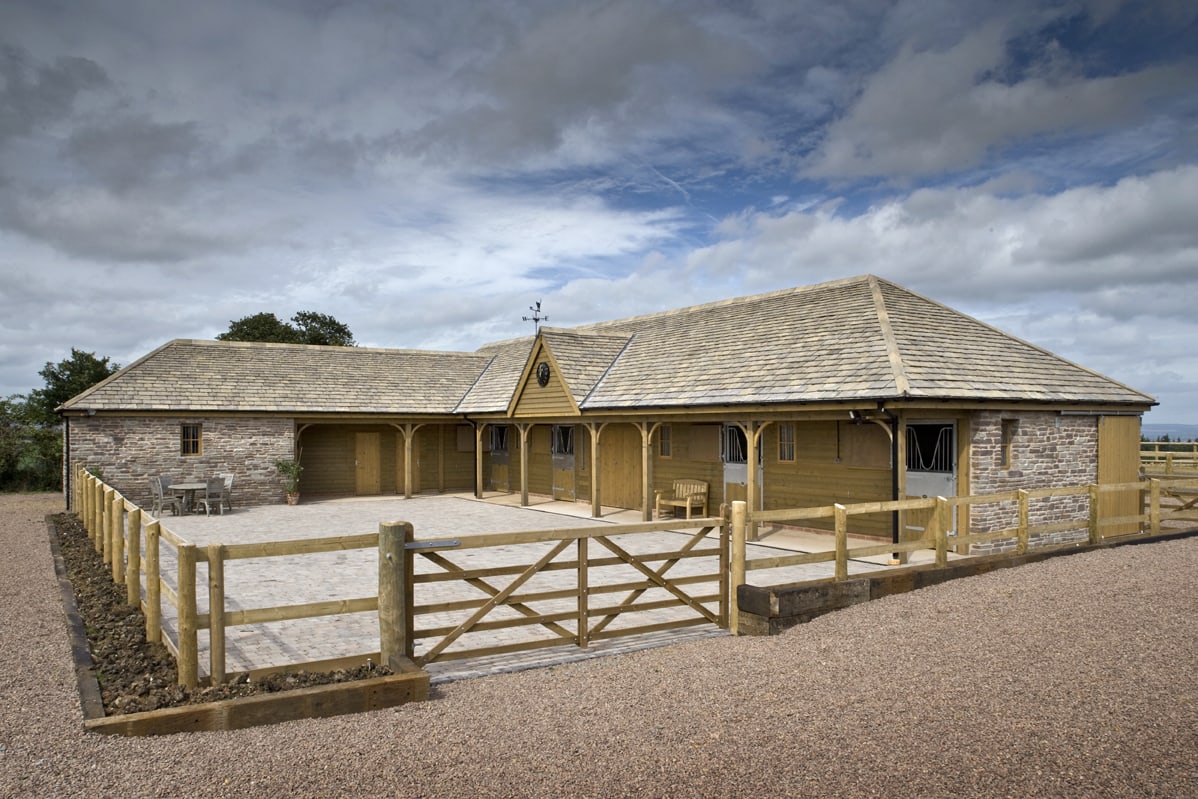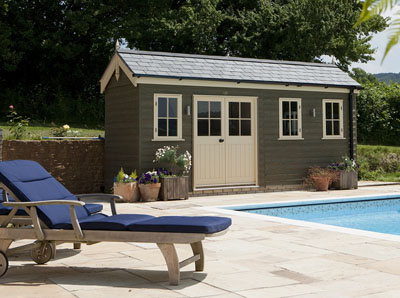While the addition of a summerhouse to your home offers a discreet and self-contained haven, it is worth considering how it can be integrated within your garden and taking time to help it settle in to its surroundings.
A fantastic way to achieve this is through the hard landscaping that supports your summerhouse, from the base to the access pathway and all the elements that surround it. Of course, your summerhouse can happily stand alone in an isolated spot and will certainly add decorative charm. However, the maximise the return on your investment, we recommend giving some thought to its immediate environs, making it easier for you to access and enjoy all year round.
Ultimately the choice of hard landscaping and decking materials will depend on your personal preferences, budget and the overall style of your summerhouse. It may be helpful to consult with a landscaping or garden design professional to determine the best options for your specific needs.
Below we explore some of the possibilities for hard landscaping to complement your summerhouse. The only real limit is your imagination, and we hope to inspire you with some creative ideas.
Firm foundation
First of all, every summerhouse needs a firm base, and we cover this topic here. Movement is the enemy of the summerhouse and because Scotts’ garden buildings are solid and built with high quality materials, it is crucial that you first create a base that can support its weight. Moisture is another major foe and so you must ensure that the base allows air to circulate under the building to help reduce damp.
Your choice of base will impact on the area immediately surrounding your summerhouse and on the overall styling of your garden, so it is worth making a review of the entire setting and deciding whether you want to make any broad-brush changes to the layout and design before your summerhouse is installed.
Paving the way
As well providing a firm base on which your garden building can stand, paving slabs and flagstones create a decorative exterior environment that offer a myriad of alternative styles and aesthetics. Paving can be a great option for creating a hard landscaped area around your summerhouse. There are many types of paving materials to choose from natural stone and concrete to brick.
Depending on the size of your plot, you may wish to choose smaller tiles, or go large if you want to cover an expansive area. Spacing should be consistent but by no means needs to always follow a traditional design. As well as standard square and rectangular shapes, paving stones are available in a range of shapes including circular and hexagonal. The way that slabs are laid can enhance their visual appeal and cleverly draw the eye to your summerhouse centrepiece. It is possible to create a visually stunning checkerboard effect from the design of differently coloured slabs. Or create a whirling spiral with an elegant octagonal summerhouse at its centre.
A warm natural sandstone augments a cottage garden, while a more urban setting could carry a brutalist grey. Use dark coloured slabs to set off a light-coloured summerhouse (take a look at the Scotts colour palette and imagine how this would work).
For a high-end contemporary vibe, you could opt for porcelain or marble tiles in white or light grey. This effect might link your garden building to the house in a seamless flow. Or you may dream of creating a Mediterranean-style setting using terracotta tiles.
Adding patterned paving slabs with a geometric design can provide a decorative border around your summerhouse. Or add an occasional coloured tile within a simple patio to add a pop of colour. This might work well if you choose one of the more vibrant colours within the Scotts’ summerhouse palette, such as Aegean Blue or Aubergine.
Put the environment at the heart of your decision-making and choose slabs from a local source. This will also ensure that they complement the construction materials with which your property was built. Select reclaimed paving slabs for your summerhouse landscaping and use a concrete mix made from recycled aggregate. Replace Portland cement with materials rescued from a landfill fate. If you can, invest in permeable paving that filters pollutants and helps to irrigate the soil beneath.
If you are wary of creating a completely paved area in front of your summerhouse, simply leave room for a strip of greenery, or a border for planting to soften its appearance.
‘All hands on deck’
Decking is a popular option for creating an outdoor living space around your summerhouse. It can be made from a variety of materials including timber, composite materials, or PVC. A timber deck will complement any Scotts summerhouse because they are all carefully crafted form ethically sourced and sustainable hardwood, Red Grandis. As all Scotts’ summerhouses are completed by a microporous spray finish in a range of paint colours, you might prefer a composite decking material that complements your garden building. Plastic-based, a composite deck is durable, and needs virtually no maintenance. It is not prone to cracking and with no splinters, this could be a suitable option if you have small children playing in your garden.
A bold charcoal black composite decking could set off a Scotts’ Sun Ray Garden Room in Wood Ash perfectly. A soft mocha works well with Forest Green. A Lilac summerhouse would look stunning against a subtle grey deck.
In the same way that paving slabs can be laid in various patterns, you can create stunning effects by laying decking boards diagonally, in a chevron pattern or picture frame style with a stylish contrasting edging. Explore the market carefully and you will find decking tiles that can be laid vertically or horizontally depending on your summerhouse position and the space it occupies.
If you feel adventurous and artistic, why not consider a curved edge to your decking design? This could be styled around an existing retaining wall if you are planning to install a corner summerhouse or could create a raised area with the curved edge segmenting a lawn. Or install a curved deck in a semi-circle around your garden building. This will work particularly well if you choose an octagonal summerhouse layout. If you have opted for a summerhouse with a rotating base, the landscaping should be consistent through 360 degrees so that no matter which way your are facing, you will benefit from an aesthetically pleasing and practical outlook.
It is easy to create specific zones within your garden with levels of different heights. Decking is particularly helpful to create summerhouse landscaping in a sloping garden. You can create a raised decking area using posts of varying heights. If your garden is steep, your can use decking to create a tiered and layered approach to your summerhouse with discreet zones for relaxing in the sun, playing games, and enjoying an evening cocktail. A ground screw base, available from Scotts, might help to stabilise your summerhouse in tandem with its surroundings.
Hardwood is the best choice of natural timber decking material, and it will complement a Scotts’ summerhouse with the same level of quality and longevity. Look for timber made from oak, iroko, balau or sweet chestnut.
No stone unturned
An easy-to-use and malleable alternative, gravel provides a lower cost but highly attractive backdrop to your summerhouse setting. It drains well and you will avoid standing water after a spring downpour. Again, choose the colour carefully, and decide whether you prefer a warmer or cooler tone depending on your summerhouse design, its interior decor, and the style of your garden furniture.
Bear in mind that gravel is available in a range of sizes. Around 20mm is the optimum grade because it is big enough to walk on easily and less likely to get stuck in shoe treads. It is best to lay gravel to a depth of about four inches and budget for around one tonne of material for every 12 square metres of space. Use an online calculator for a more specific estimate.
Gravel can stand alone or be laid to complement paving stones, creating a decorative edge or border. It is possible to create a sculptural effect using large stones, and you could incorporate a rockery that leads the eye to our summerhouse door. Corten steps made from steel frames are filled with gravel and can be faced with wood to provide a stunning finish.
Check the source of your gravel and avoid any that is harvested from the seabed in the interests of protect the environment. Choose recycled gravel from crushed concrete instead. While gravel represents a highly decorative and low-cost landscaping option it is not suitably solid or firm enough to rely on for a summerhouse base.
Concrete evidence
Traditionally associated with the Brutalist architecture of the 1950s, concrete has its detractors but there is no escaping its strength and longevity. Installed, a concrete base will support your summerhouse for many years. Broaden its extent to create an attractive and appealing setting for outdoor living.
Options to increase the aesthetic appeal of concrete landscaping include pouring it in sections to break up the visual impact, adding texture using a stamp before it dries, or stencilled patterns when the surface has hardened and properly dried. Choose colours that complement your summerhouse style aesthetic.
Concrete does not have to remain grey. Paint it all over for a vibrant setting or add a patchwork of intricate colours according to your style preferences and overall summerhouse theme. You can also soften a concrete patio with an outdoor rug. Choose from natural fibres such as jute, sisal, hemp, or seagrass. Synthetic alternatives will provide long-lasting floor coverings that you can wash with a garden hose.
Landscaping extends beyond what is underfoot, and concrete can be useful to create an outdoor bar or kitchen, a garden bench, or an enduring base for a romantic fire pit.
And finally
Gardening is one of our favourite hobbies in the UK and there are so many options for creating the perfect landscape to complement your summerhouse setting. If you are keen to minimise maintenance or have restricted mobility, you could opt for artificial grass. This could surround your garden building or adorn the floor inside for a year-round summer feel.
Think about accessories such as mirrors and their reflections to open up even the smallest garden space. Install attractive trellises or a pergola next to your summerhouse but be mindful of trailing plant debris and try to keep the roof clear.
Chat to our team about any of the ideas in this blog or draw on our expertise for further inspiration specially for your garden summerhouse project. We are looking forward to hearing from you.










